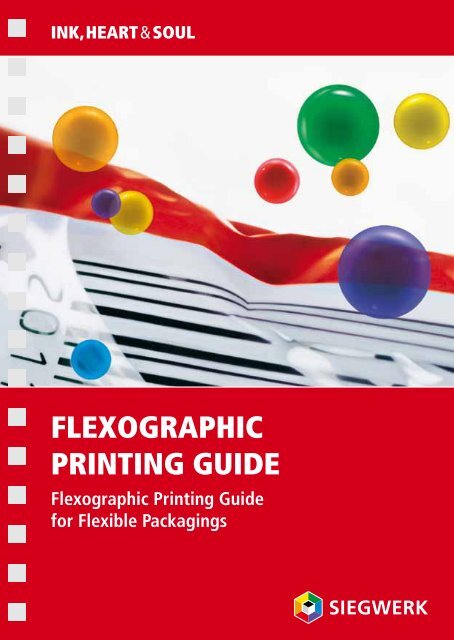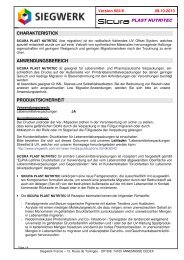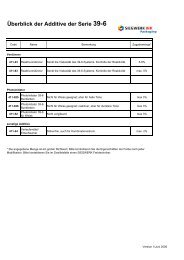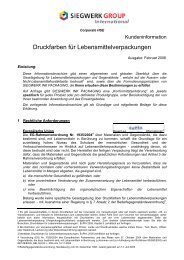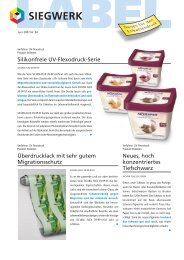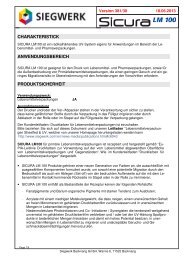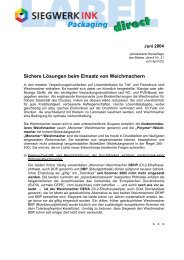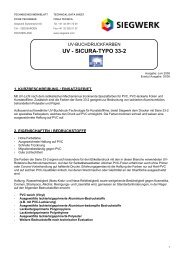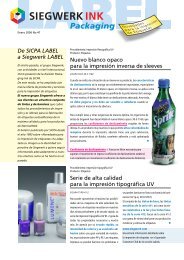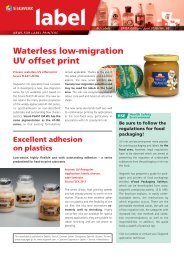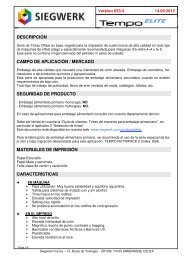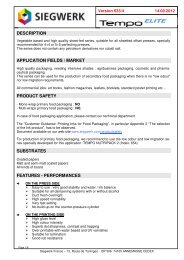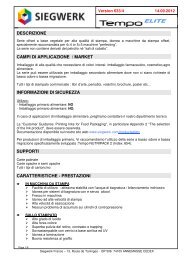FLEXOGRAPHIC PRINTING GUIDE - Siegwerk
FLEXOGRAPHIC PRINTING GUIDE - Siegwerk
FLEXOGRAPHIC PRINTING GUIDE - Siegwerk
Create successful ePaper yourself
Turn your PDF publications into a flip-book with our unique Google optimized e-Paper software.
FlexographicPrinting GuideFlexographic Printing Guidefor Flexible Packagings
Creating the perfect result together<strong>Siegwerk</strong> is one of the world's leading printing ink manufacturersand stands for innovative strength, a practical approach and stateof-the-arttechnologies. With great passion, the people at <strong>Siegwerk</strong>develop individual printing ink solutions together with their customers.And what is more: they also advise them on the developmentof new applications and technologies and provide them with rapidand pragmatic help when they have problems.For the employees at <strong>Siegwerk</strong> it is always the customers who arethe focus of attention. They are on hand when it is important toavoid errors, optimize processes and support customers with all oftheir knowledge for printing and packaging production.2
Flexographic Printing Guide ∙ Flexible PackagingsWho needs a flexographic printing guide?In spite of the extensive improvements in flexographic printing technology,most printing shops do not make use of the full capabilitiesoffered by their machines.Studies have shown that 70% of all errors are directly associatedwith the processes. This guide is intended to help you to solveproblems with all aspects of printing:Fault detectionIn order to avoid misunderstandings and misinterpretations, you canidentify by means of the illustrated explanations which problemsyou are facing in your printing shop.Cause identification and remediesThe causes and adjustments for the most important corrections arelisted here in order to help you to identify your problem. For furtherdetails, please contact your <strong>Siegwerk</strong> representative.The flexographic printing guide published by <strong>Siegwerk</strong> offers youthe possibility of quickly identifying and correcting problems so thatyou can increase your printing productivity.3
Flexographic Printing Guide ∙ Flexible PackagingsContentsTape resistance 6Bleeding – smudging 8Blocking 10Bridging 12Deformed screen dot 14Dot gain too high 16Inaccurate printing of the screen dots 18Ink build-up on motif edges 20Ghosting effect 22Halo effect/squeezed edge on the screen dot 24Minor printing defects 26Large-area printing defects 28Longitudinal stripes 30Ink mottling 32Mechanical damage of the printed image 34Moiré effect 36Pinholes 38Color strength too low 40Register 42Repeat length 44Color strength too high 46Transverse stripes 485
WitherrorWithouterror6
Flexographic Printing Guide ∙ Flexible PackagingsTape resistanceThe ink does not pass the adhesive tape test. There is insufficientadhesion of the ink to the substrate.CAUSESAn inappropriate ink formulation orincorrect ink system was used.The corona pretreatment level of thefilm is too low.The pH value of the water inks ismuch too low in the case of prolongedprinting times.The adhesion between colors isinsufficient.The film surface is soiled.The ink viscosity is too low.Multiple color build-upThe wrong side of the film has beenprinted.REMEDIESPlease ensure that the correct inksystem is used.Check the pretreatment and the ageof the film.Please use fresh ink. Ensure that thecorrect solvents are used.This can occur if two different inksystems are printed one over theother. Ensure that the ink build-up isappropriate.Apply an appropriate primer beforeyou begin printing or change to amore suitable film batch.Increase the viscosity with fresh ink.Please ensure that the ink that is firstapplied displays good initial adhesionand is not dissolved by the followingink.Check the side of the film.7
WitherrorWithouterror8
Flexographic Printing Guide ∙ Flexible PackagingsBleeding – smudgingThe terms bleeding or smudging are used in situations when coloredconstituents of the printing ink become visible in parts of themotif which have not been printed.(The previous ink must be dry enough to be able to absorb the ink that is tobe applied subsequently).CAUSESThe relative humidity is too high.Condensation of water into thesolvent-based ink.Too much retarder has been used.The ink viscosity is too high.The transferred volume is too high.The printing speed is too high.Unsuitable colorants have been usedin the printing ink.There are too many ink layers on topof one another.REMEDIESUse fresh ink. Adjust the solvent mixture.Increase the performance of thedryer and check the water content ofthe solvent.Replace the ink with fresh ink. Usea faster solvent for the purposes ofreduction (accelerated drying).Add solvent to reduce the viscosity.Replace the anilox roller.Reduce the printing speed. Increasethe drying speed of the ink.Create a new recipe to replace theundesirable colorants.Reduce the layers. Design a newprinted motif.9
WitherrorWithouterror10
WitherrorWithouterror12
Flexographic Printing Guide ∙ Flexible PackagingsBridgingInk connections between individual screen dots of the printing plateare produced. The intermediate depressions are filled with ink.CAUSESThe relative humidity is too high.Water is condensing into the solventbasedinks.The ink recipe is not suitable for theprinted motif.Incorrect selection of the solvent. Theink dries too quickly.The ink viscosity is too high.The transferred volume is too high.The anilox roller and width of theprinting plate raster do not match.REMEDIESReplace with fresh ink. Adjust thesolvent mixture. Increase the performanceof the dryer between theprinting unitsReplace the ink.Empty the ink tank and adjust thesolvent mixture.Reduce the viscosity.For the print job, select anilox rollerswith a lower transferred volume.Use a finer anilox roller.13
WitherrorWithouterror14
WitherrorWithouterror16
Flexographic Printing Guide ∙ Flexible PackagingsDot gain too highExcessive dot gain on the substrate. This reduces the details and thecontrast.CAUSESThe thickness tolerance of theprinting plate or the double-sidedadhesive tape is too large.The printing plate is too soft or thedouble-sided adhesive tape too hard.The pressure setting between theplate cylinder and substrate is toohigh.The thickness tolerance of the film istoo high.The dot gain has been incorrectlycalculated.The temperature of the central cylinderis too high or too low.REMEDIESChange the printing plate or thedouble-sided adhesive tape.Replace the printing plate or theadhesive tape.Reduce the pressure setting.Reduce the pressure of the platecylinder or replace the roller ofsubstrate.Adapt the curve of the dot gainaccordingly.Please contact the maintance servicedepartment.17
WitherrorWithouterror18
Flexographic Printing Guide ∙ Flexible PackagingsInaccurate printing of the screen dotsUneven edges around the screen dot.CAUSESThe ink dries on the printing plate.The pressure setting between theanilox roller and the plate cylinder istoo high.The ink viscosity is too high.The lint particles from the cleaningcloth are on the printing plate.The ink recipe is not suitable for theprinted motif.The pressure setting between theplate cylinder and the substrate istoo high.REMEDIESClean the printing plate and adjustthe solvent mixture. Add the retarder.Make sure that the hot air fan is notblowing onto the printing plate.Reduce the pressure setting.Adapt the ink viscosity by addingsolvents.Clean the printing plate. Use alint-free cleaning cloth or a cleaningbrush.Replace the ink.Reduce the pressure setting.19
WitherrorWithouterror20
Flexographic Printing Guide ∙ Flexible PackagingsInk build-up on motif edgesInk build-up on the relief edge of the screen dot.CAUSESThe transferred volume of the aniloxroller is too high.The printing speed is too low.The ink viscosity is too high.The wrong solvents were used.The pressure setting between theplate cylinder and substrate is toohigh.The ink recipe is unsuitable.The printing plate is worn, the reliefdepth is too small.The relative humidity is too high. Thewater condenses into the solventbasedink.REMEDIESUse an anilox roller with a smallertransferred volume.Clean the printing plate and increasethe printing speed.Reduce the viscosity.Replace the ink.Reduce the pressure setting.Replace the ink.Replace the printing plate.Adjust the solvent mixture – useretarder and anhydrous solvent.21
WitherrorWithouterror22
WitherrorWithouterror24
Flexographic Printing Guide ∙ Flexible PackagingsHalo effect/squeezed edge on the screendotThe screen dot is surrounded by a line or a ring.CAUSESThere is a difference in the speedbetween the plate and impressioncylinder.The transferred volume of the aniloxroller is too high.The pressure setting between theplate cylinder and substrate is toohigh.The pressure of the chamber doctorblade system is too low.The pressure setting between theanilox roller and the plate cylinder istoo high.REMEDIESCheck the thickness of the doublesidedadhesive tape and the printingplate.Select an anilox roller with a lowertransferred volume.Reduce the pressure setting.Increase the pressure in the chamberdoctor blade system.Reduce the pressure setting.25
WitherrorWithouterror26
Flexographic Printing Guide ∙ Flexible PackagingsMinor printing defectsDust particles on the substrate cause spots and defects. This is thecase with solid printing, where dark spots are surrounded by awhite 'halo'.CAUSESThe feed is dirty.The printing plate is dirty or the surroundingsare too dusty.There are foreign particles in the doctorblade chamber.The substrate is statically charged.The substrate is dirty.The feed rollers are dirty.REMEDIESClean the feed.Clean the printing plate.Clean the ink feed system.Use antistatic rollers if possible, orreplace the reel of substrate.Change the substrate.Clean the feed rollers.27
WitherrorWithouterror28
Flexographic Printing Guide ∙ Flexible PackagingsLarge-area printing defectsLack of contact between the substrate and the printing plate orbetween the printing plate and anilox roller results in the poortransfer of ink.CAUSESThe thickness fluctuations in theprinting plate or double-sided adhesivetape are too large.The printing pressure is too low.The thickness of the substrate is outof tolerance.The plate cylinder or the anilox rollerare imbalanced.The transferred volume of the aniloxroller is too low.The filling level of the chamber doctorblade is too low.REMEDIESChange the printing plate or thedouble-sided adhesive tape.Increase the pressure between theplate cylinder and anilox roller orbetween the plate cylinder and thesubstrate.Increase the delivery pressure of theplate cylinder or replace the reel ofsubstrate.Check the running of the printingplate cylinder (concentricity etc.).Increase the anilox roller volume.Increase the ink level in the chamberdoctor blade. Check whether the inkpump is working correctly.29
WitherrorWithouterror30
Flexographic Printing Guide ∙ Flexible PackagingsLongitudinal stripesPrinting error owing to parallel lines in the direction of printing.CAUSESThe doctor blade is worn.There is dried ink on the doctorblade.The anilox roller is damaged.The anilox roller is blocked or thedrive of the anilox roller is faulty.The anilox roller is dirty or the ink onthe anilox roller has dried.There are particles in the ink.REMEDIESReplace the doctor blade.Clean the doctor blade.Replace the anilox roller.Please contact the maintance servicedepartment.Clean the anilox roller.Clean the pump system, printingplates, doctor blade and anilox rollerafter you have filtered the particlesout of the ink.31
WitherrorWithouterror32
Flexographic Printing Guide ∙ Flexible PackagingsInk mottlingDotted or marbling printed image of the solid printing area. Weakink strength, grainy large-format printing.CAUSESThe surface of the printing plateis cloudy/uneven. Damage to thesurface of the printing plate can beseen.The viscosity of the ink is too low.There are foreign bodies or impuritieson the plate cylinder or the aniloxroller.The surface of the substrate isuneven.The film surface is soiled.The ink viscosity is too high.The doctor blade pressure is too highor too low.REMEDIESCreate a new printing plate.Add fresh ink and/or a blend of inksand ensure that the resulting viscosityis appropriate.Clean the plate cylinder carefully.Use softer printing plates.Filter the ink or use fresh ink.Add solvent to the ink.Adapt to the doctor blade pressureaccordingly.33
WitherrorWithouterror34
Flexographic Printing Guide ∙ Flexible PackagingsMechanical damage of the printed imageInsufficient mechanical resistance of the print. Further informationcan be found in our brochure 'Rapid tests and test methods forproduction control in packaging printing'.CAUSESThe ink recipe is not suitable or theink is damaged.The transferred volume of the aniloxroller is too low.An unsuitable solvent has beenselected.The corona pretreatment of the filmis insufficient.The abrasion resistance is poor.REMEDIESEmpty the ink tank, clean the inkfeed system and replace the ink.Replace the anilox roller.Use fresh ink with the appropriatesolvent mixture.Use inline corona pretreatment.Add a wax additive to the ink.35
WitherrorWithouterror36
Flexographic Printing Guide ∙ Flexible PackagingsMoiré effectIn the overprinting of the process colors (CYMK) the individual gridstructures can interact and create a pattern. The type of interactioncan create an undesirable interference pattern , the so-called moiréeffect.CAUSESThe screen angle on the printingplate is wrong.The ratio between the line numberof the anilox roller and the screenfrequency of the printing plate istoo low.The ink dries on the anilox roller.The anilox roller angle and the screenangle on the printing plates is incorrectlyadjusted.REMEDIESAdjust the screen angle in the preliminarystage.The ratio should be greater than 4;use at least a 200 anilox roller, forexample, for a 48 plate raster.Clean the anilox roller. Add retarderto the ink.Change the anilox roller or revisethe repro with more suitable screenangles.37
WitherrorWithouterror38
Flexographic Printing Guide ∙ Flexible PackagingsPinholesSmall bright points in the solid print area.CAUSESThe surface of the film or printingplate is uneven.The substrate is unevenly wetted.The ink foams.The pH value of the water inks istoo low.The printing pressure is too low.An inappropriate white ink has beenselected.REMEDIESIncrease the pressure setting orreplace the film or the printing plate.Use more appropriate material to beprinted on or increase the ink layerthickness through a higher viscosityor by exchanging the anilox roller.Add defoaming agent.Carry out pH value correction.Increase the printing pressure.Use an appropriate white ink.39
WitherrorWithouterror40
Flexographic Printing Guide ∙ Flexible PackagingsColor strength too lowThe color strength is weaker in comparison to previous prints orsamples.CAUSESThe ink dries on the anilox rollers.The color of the printing ink beingused his too weak.The ink is too thin.The anilox roller is worn.The ink is of incorrect quality.The printing pressure is too high ortoo low between the plate cylinderand the substrate or between theanilox roller and the plate cylinder.The ink has dried because a machinehas been at a standstill for too long.An anilox roller has been used whosetransferred volume was too small.REMEDIESClean the anilox roller. The printingpressure is too high or too lowbetween the plate cylinder and thesubstrate or between the anilox rollerand printing plate.Contact your ink supplier or, if possible,add a concentrated ink.Increase the viscosity with fresh ink.Replace the anilox roller.Replace this with fresh ink.Adjust the printing pressure.Clean the printing plate and theanilox roller.Select an anilox roller with a highertransferred volume.41
WitherrorWithouterror42
Flexographic Printing Guide ∙ Flexible PackagingsRegisterIn combined printing the individual colors are not congruent withone another.CAUSESThe printing plate has been incorrectlymounted.The dryer temperature is too high.The tensile stress of the printing substrateweb is incorrectly adjusted.The thickness fluctuations of thesubstrate are too high.REMEDIESRepeat the mounting procedure forthe printing plate.Reduce the temperature of theIntermediate ink dryer.Check the web tension, as well asthe feed and the winder.Replace the reel of substrate.43
WitherrorWithouterror44
Flexographic Printing Guide ∙ Flexible PackagingsRepeat lengthThe printed motif in the direction of printing is too short or toolong.CAUSESThe web tension is too high or toolow.The thickness deviation of the substrateis too large.The temperature in the tunnel dryeris too high.REMEDIESAdjust the web tension in accordancewith the properties of the substrate.Change the substrate.Reduce the temperature in the tunneldryer.45
WitherrorWithouterror46
Flexographic Printing Guide ∙ Flexible PackagingsColor strength too highThe color strength is too high in comparison to previous prints orsamples.CAUSESThe transferred volume of the aniloxroller is too high.The ink viscosity is too high.The ink recipe for the color matchingis too strong.The settings of the doctor blade areincorrect.REMEDIESUse an anilox roller with a smallertransferred volume.Add solvent and/or blended inks inorder to adjust the ink viscosity.Add a blend of inks. Optimize theink recipe.Adjust the pressure of the doctorblade.47
WitherrorWithouterror48
Flexographic Printing Guide ∙ Flexible PackagingsTransverse stripesIncorrect printing owing to lines that are perpendicular to the lineof printing.CAUSESThe diameters of the printing platecylinder and the gear used do notmatch.The pressure setting between theplate cylinder and the substrate istoo high.The printing speed is too high.The printing pressure between theanilox roller and the printing plate isincorrect.There is a mechanical fault.REMEDIESCheck the amount of unwoundmaterial.Reduce the pressure setting.Reduce the printing speed.Adjust the printing pressure.Check the mechanical parts of theprinting machine.
Flexographic Printing Guide ∙ Flexible PackagingsImprintPrinted in March 2013Photos: <strong>Siegwerk</strong> Druckfarben AG & Co. KGaAPrinting ink: <strong>Siegwerk</strong> Tempo Elite<strong>Siegwerk</strong> and the <strong>Siegwerk</strong> logo are registered trademarks of <strong>Siegwerk</strong>Subject to technical and other changes<strong>Siegwerk</strong> Druckfarben AG & Co. KGaAAlfred-Keller-Str. 55 · 53721 SiegburgGermanyinfo@siegwerk.com51
www.siegwerk.com


